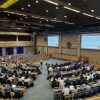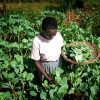Tuesday, May 14, 2024
News and Views from the Global South
Global Green Growth Institute (GGGI)
Indonesia Unveils Low Carbon Development Framework

A woman works in her vegetable patch at the foot of Mount Sinabung, North Sumatra, Indonesia. Indonesia is one of the world’s largest emitters of greenhouse gases (GHG) that cause global warming on our now beleaguered planet Earth.Credit: Kafil Yamin/IPS
- Indonesia is convinced that low carbon development and a green economy are key to further boosting economic growth without sacrificing environmental sustainability and social inclusivity.
Low carbon development, also called low emission development strategies or low carbon growth plans, refers to economic development plans or strategies that promote low emissions and or climate-resilient economic growth.
“It is timely for Indonesia to put in place sustainable development principles that balance the economic, social and environmental aspects. In this context, the government of Indonesia has committed to become the pioneer of sustainable development by initiating the LCDI [Low Carbon Development Indonesia report] and at the same time, preparing and implementing green financing mechanisms,” minister of national development planning (BAPPENAS) Bambang Brodjonegoro said.
He was launching the LCDI report that spells out the country’s green development path at the “Conference on Low Carbon Development and Green Economy” organised by the Indonesian government on Thursday, Oct. 11.
Organised as part of the 2018 International Monetary Fund-World Bank Group Annual Meetings that run through Oct. 14, the conference was co-hosted by several international institutions that help Indonesia in mapping and designing green growth programmes, including the UK Climate Change Unit, the Global Green Growth Institute (GGGI), the Indonesian Climate Change Trust Fund, the New Climate Economy, and the World Resources Institute Indonesia.
The renewed stance towards green growth comes as the archipelago island nation is recovering from a 7.5 magnitude earthquake and a resultant tsunami that hit its Sulawesi Island on Sept. 28. There were an estimated 2,000 casualities.
It was followed Thursday Oct. 11 by another earthquake of 6.0 magnitude which hit the tourist area of Bali, where the current IMF-World Bank Group Annual Meetings are being held.
Indonesia is one of the world’s largest emitters of greenhouse gases (GHG) that cause global warming on our now beleaguered planet Earth.
In 2012, Indonesia produced a total of 1,453 gigatonnes of carbon dioxide equivalent (GtCOe), an increase of 0,459 GtCOe from the year 2000, according to the first Nationally Determined Contribution (NDC) Indonesia submitted to the United Nations. At least 47.8 percent of the country’s GHG emissions came from land-use change and forestry, including peatland fires, followed by emissions from the energy sector, at 34.9 percent.
In 2015, Indonesia set an ambitious target to reduce GHG emissions by 29 percent under the business-as-usual scenario, and by 41 percent with international assistance and financial support by 2030. The same target was put in the NDC submitted to the U.N. under the Paris Agreement, which seeks to slow down warming to between 1.5 and 2 degrees Celsius.

Marcel Silvius, GGGI Indonesia country representative at his office in Jakarta, Indonesia. Credit: Kanis Dursin/IPS
“The pledge puts Indonesia in a vulnerable position,” Marcel Silvius, Indonesia Country Representative of GGGI, an inter-governmental organisation that supports the implementation of green growth in Indonesia, told IPS. “It sets the agenda for former, current, and future governments.
“That is very brave, it is something that is lacking in other governments. There are very strong positive signals that Indonesia is a country that other countries look at as an example and they want Indonesia to succeed,” he added
“Countries that are not so forthcoming in their pledges will receive less foreign collaboration. So, it is all positive for Indonesia. I think Indonesia is leading on certain fronts, one clearly is on the peat land restoration, only a few countries put so much emphasis on rehabilitation of this ecosystem, Indonesia is one and Russia is another,” Silvius said.
In September, President Joko “Jokowi” Widodo instructed related ministries and regional governments to stop issuing new permits for oil palm plantations, which are often blamed for forest and peatland fires, and to review existing ones for possible revocation.
In January 2016, the government established the Badan Restorasi Gambut or Peatland Restoration Agency. Directly under the president, the agency is tasked with restoring 20,000 square kilometres of degraded peat forest by 2020.
“I think Indonesia in many respects has been braver compared to other countries such as the United States, [and] even Europe. Indonesia has taken the right steps that we don’t see in other countries, including in developed countries,” Silvius said.
He also praised Indonesia’s decision to organise the conference on low carbon development and the green economy during the IMF-World Bank Group Annual Meetings in Bali.
“The event gives a strong policy signal and creates a proper investment climate for organisations like the IMF and the World Bank and countries who are members of the World Bank and the IMF. The government also needs to give this kind of signals to the private sector,” Silvius told IPS in the interview in Jakarta.
The conference included panel discussions featuring several prominent speakers including former vice president Boediono, former trade minister Mari Elka Pangestu, Co-Chair of the Global Commission on the Economy and Climate Ngozi Okonjo-Iweala, CEO of Unilever and Co-Chair of the Global Commission on the Economy and Climate Paul Polman, and LCDI Commissioner and Co-Chair of the Global Commission on the Economy and Climate Lord Nicholas Stern.
During the discussions, the speakers and participants shared their knowledge on the green economy, including business models that incorporate inclusive development and GHG emission reductions and ensure maintenance and restoration of natural capital, sectorial financing priorities and challenges, as well as strategies on how to effectively implement low carbon development.
The LCDI serves as a guideline in designing a development plan. If followed accordingly, the framework is “expected to accelerate rapid economic growth, reduce the poverty rate, and decrease greenhouse gas” emissions.
“To underline this commitment of implementing LCDI, the ministry of national development planning will mainstream the LCDI report on low carbon development framework into our next five years 2020-2024 National Medium Term Development Plan. This will become the very first ever low carbon development plan in the history of Indonesia,” said Brodjonegoro.
Recent global research suggested that bold climate action could deliver 26 trillion dollars in economic benefits in the form of new jobs and better health outcomes globally from now to 2030, compared to the business-as-usual approach.
Frank Rijsberman, Director General of GGGI, explained that foreign and domestic capital was available for the development of green projects, but that private investors require a sound supportive policy framework to help de-risk their investments in innovative green projects.
“There needs to be a strong collaboration of trusted global institutions and leaders from government and the private sector that are committed to green growth. This can certainly bring a significant change, which is very much needed by Indonesia for a better, cleaner, and more prosperous future,” Rijsberman said.
Meanwhile, the World Bank hailed Indonesia’s implementation of its NDC but warned that the current policy framework was still a challenge.
“Indonesia is making significant strides in the implementation of its NDC, including in aspects of mitigation and adaptation. However, the current policy, regulatory, and governance framework for forested landscapes remains a challenge,” Ann Jeannette Glauber, lead Environment Specialist for the World Bank, told IPS via email.
The World Bank, Glauber said, has worked with the Indonesian government, private sector, and civil society to support the country’s efforts to move toward a green growth trajectory, including providing knowledge, partnership and financing support.
“We continue to stand ready to support the government of Indonesia with technical assistance and financing support to meet their green growth objectives at their request,” Glauber said.
And what is the way forward for the country? With all the pledges and programmes to cut gas emissions, Indonesia, according to Silvius, needs support.
“I don’t think any government in the world can do these things on their own including developed countries. There should be real collaboration and transfer of knowledge between countries, financial collaboration and assistance. Indonesia cannot do it on its own,” he said.
-
ProsperityForRI

 Print
Print



